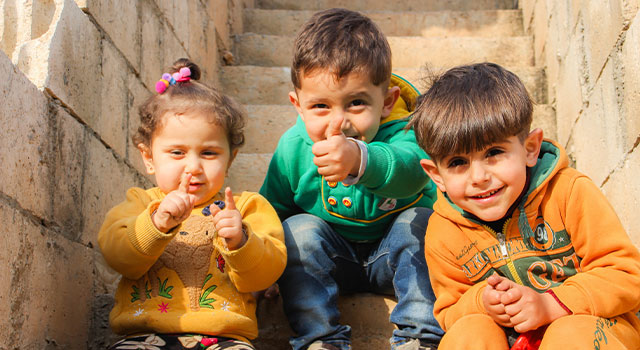 Amblyopia, commonly known as ‘lazy eye,’ is a neuro-developmental vision condition that begins in early childhood, usually before the age of 8.
Amblyopia, commonly known as ‘lazy eye,’ is a neuro-developmental vision condition that begins in early childhood, usually before the age of 8.
Lazy eye develops when one eye is unable to achieve normal visual acuity, causing blurry vision in the affected eye—even when wearing glasses. Left untreated, amblyopia can lead to permanent vision loss in one eye.
It’s important to understand that a lazy eye isn't actually lazy. Rather, the brain doesn’t process the visual signals from the ‘lazy’ eye. Eventually, the communication between the brain and the weaker eye deteriorates further, potentially leading to permanently reduced vision in that eye. Fortunately, vision therapy can improve the condition by training the brain to work with both eyes equally.
What Causes Lazy Eye?
When the neural connections between the eyes and the brain are healthy, each eye sends a visual signal to the brain. The brain combines these two signals into one clear image, allowing us to properly see what we are looking at.
In the case of amblyopia, the brain doesn’t recognize the weaker eye's signals. Instead, it relies only on the visual input from the stronger eye.
Amblyopia can be caused by strabismus, anisometropia and deprivation.
Strabismus
Strabismus occurs when the eyes are misaligned and point in different directions. The most common cause of amblyopia is eye misalignment, which causes the brain to receive two images that cannot be combined into one single, clear image.
A child's developing brain cannot process images when both eyes are not aligned in the same direction, so it ‘turns off’ the images sent by the weaker eye. This is the brain's defense mechanism against confusion and double vision.
As the brain ‘turns off’ the weaker eye, this eye will eventually become 'lazy'—unless treatment is provided.
Anisometropia
Anisometropia is when the refractive powers (visual acuity) of your eyes differ markedly, causing your eyes to focus unevenly - rendering the visual signal from one eye to be much clearer than the other. The brain is unable to reconcile the different images each eye sends and chooses to process the visual signal from the eye sending the clearer image. The brain begins to overlook the eye sending the blurrier image, further weakening the eye-brain connection of the weaker eye. If not treated, this results in permanent poor vision in that eye.
Deprivation
Deprivation refers to a blockage or cloudiness of the eye. When an eye becomes cloudy, it directly impacts the eyes’ ability to send a clear image to the retina, harming the child's ability to see images clearly from that eye. When clear images can't reach the retina, it causes poor vision in that eye, resulting in amblyopia. Deprivation is by far the most serious kind of amblyopia, but it is also incredibly rare.
There are several types of deprivation: cataracts, cloudy corneas, cloudy lenses and eyelid tumors. Each of these can affect a child's vision, resulting in amblyopia. Because these are also difficult to notice from a child's behavior, it's crucial to have your child tested for eye-related problems so that treatment can begin right away.
How To Treat Amblyopia
The goal of most amblyopia treatments is to naturally strengthen the weaker eye so that your child's eyes can work and team with the brain more effectively. Amblyopia treatment will be determined by the cause and severity of their condition.
Common types of treatment include:
- Corrective eyewear
- Eye drops
- Patching
- Vision Therapy
Vision Therapy
Vision therapy is the most effective treatment for amblyopia, which may be used in conjunction with other treatments.
A vision therapy program is customized to the specific needs of the patient. It may include the use of lenses, prisms, filters, occluders, and other specialized equipment designed to actively make the lazy eye work to develop stronger communication between the eye and the brain.
Vision therapy is highly successful for the improvement of binocular vision, visual acuity, visual processing abilities, depth perception and reading fluency.
Vision therapy programs for amblyopia may include eye exercises to improve these visual skills:
- Accommodation (focusing)
- Binocular vision (the eyes working together)
- Fixation (visual gaze)
- Pursuits (eye-tracking)
- Saccades (eye jumps)
- Spatial skills (eye-hand coordination)
- Stereopsis (3-D vision)
Contact Vision Therapy Center at EYEcenter Optometric to make an appointment and discover how vision therapy can help improve your child’s vision. Our eye doctor will ask about your child’s vision history, conduct a thorough evaluation, and take your child on the path to effective and lasting treatment.
Q: How do I know if my child has lazy eye?
- A: It’s difficult to recognize lazy eye because the condition usually develops in one eye, and may not present with a noticeable eye turn. As such, children generally learn how to ignore the lazy eye and compensate by mainly relying on the sight from the ‘good’ eye. Some symptoms of lazy eye include:
- - Closing one eye or squinting
- Difficulty with fine eye movements
- Poor depth perception
- Poor eye-hand coordination
- Reduced reading speed and comprehension
- Rubbing eyes often
Q: How is lazy eye diagnosed?
- A: Your child’s eye doctor will conduct specific tests during their eye exam, to assess the visual acuity, depth perception and visual skills of each eye.
Vision Therapy Center at EYEcenter Optometric serves patients from Citrus Heights, Rocklin, Folsom, and Sacramento, all throughout California .
